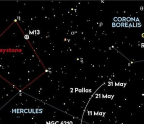
Over the last few years there has been an explosion of multi-band filters for astrophotographers. Used with a colour astro camera, they help to combat light pollution and make it easier to image deep-sky targets from cities. Compared to mono cameras, one-shot colour cameras also help in this regard as they save time imaging. Combining data captured with a multi-band filter and with a standard light-pollution filter allows some good creativity when it comes to processing; the colour can be changed, and stars moved from one image to another to give some very impressive results.
Here we have examined a selection of multi-band filters to look at the differences in the wavelength of light they let pass through to the camera sensor. There are dual-band filters, which mainly pass the light emission from ionised hydrogen alpha (Ha) and oxygen III (OIII) (though some are now passing sulphur II (SII) and OIII emission), which can enhance the detail within nebulae. There are tri-band filters too, which generally have the addition of passing hydrogen beta emission,






